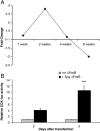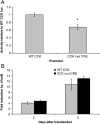DeltaFosB indirectly regulates Cck promoter activity
- PMID: 20226774
- PMCID: PMC2876727
- DOI: 10.1016/j.brainres.2010.02.081
DeltaFosB indirectly regulates Cck promoter activity
Abstract
Some of the important biochemical, structural, and behavioral changes induced by chronic exposure to drugs of abuse appear to be mediated by the highly stable transcription factor DeltaFosB. Previous work has shown that DeltaFosB overexpression in mice for 2weeks leads to an increase in the expression of numerous genes in striatum, most of which are later downregulated following 8weeks of FosB expression. Interestingly, a large number of these genes were also upregulated in mice overexpressing the transcription factor CREB. It was unclear from this study, however, whether short-term DeltaFosB regulates these genes via CREB. Here, we find that 2weeks of DeltaFosB overexpression increases CREB expression in striatum, an effect that dissipates by 8weeks. The early induction is associated with increased CREB binding to certain target gene promoters in this brain region. Surprisingly, one gene that was a suspected CREB target based on previous reports, cholecystokinin (Cck), was not controlled by CREB in striatum. To further investigate the regulation of Cck following DeltaFosB overexpression, we confirmed that short-term DeltaFosB overexpression increases both Cck promoter activity and gene expression. It also increases binding activity at a putative CREB binding site (CRE) in the Cck promoter. However, while the CRE site is necessary for normal basal expression of Cck, it is not required for DeltaFosB induction of Cck. Taken together, these results suggest that while short-term DeltaFosB induction increases CREB expression and activity at certain gene promoters, this is not the only mechanism by which genes are upregulated under these conditions.
Copyright 2010 Elsevier B.V. All rights reserved.
Figures





Similar articles
-
Regulation of gene expression and cocaine reward by CREB and DeltaFosB.Nat Neurosci. 2003 Nov;6(11):1208-15. doi: 10.1038/nn1143. Epub 2003 Oct 19. Nat Neurosci. 2003. PMID: 14566342
-
cAMP response element-binding protein is required for dopamine-dependent gene expression in the intact but not the dopamine-denervated striatum.J Neurosci. 2001 Dec 15;21(24):9930-43. doi: 10.1523/JNEUROSCI.21-24-09930.2001. J Neurosci. 2001. PMID: 11739600 Free PMC article.
-
CREB-binding protein controls response to cocaine by acetylating histones at the fosB promoter in the mouse striatum.Proc Natl Acad Sci U S A. 2005 Dec 27;102(52):19186-91. doi: 10.1073/pnas.0509735102. Proc Natl Acad Sci U S A. 2005. PMID: 16380431 Free PMC article.
-
Delta FosB mediates epigenetic desensitization of the c-fos gene after chronic amphetamine exposure.J Neurosci. 2008 Jul 16;28(29):7344-9. doi: 10.1523/JNEUROSCI.1043-08.2008. J Neurosci. 2008. PMID: 18632938 Free PMC article.
-
Molecular mechanisms of drug addiction.Neuropharmacology. 2004;47 Suppl 1:24-32. doi: 10.1016/j.neuropharm.2004.06.031. Neuropharmacology. 2004. PMID: 15464123 Review.
Cited by
-
An important role for cholecystokinin, a CLOCK target gene, in the development and treatment of manic-like behaviors.Mol Psychiatry. 2014 Mar;19(3):342-50. doi: 10.1038/mp.2013.12. Epub 2013 Feb 12. Mol Psychiatry. 2014. PMID: 23399917 Free PMC article.
-
Differential regulation of the period genes in striatal regions following cocaine exposure.PLoS One. 2013 Jun 11;8(6):e66438. doi: 10.1371/journal.pone.0066438. Print 2013. PLoS One. 2013. PMID: 23776671 Free PMC article.
-
Direct regulation of diurnal Drd3 expression and cocaine reward by NPAS2.Biol Psychiatry. 2015 Mar 1;77(5):425-433. doi: 10.1016/j.biopsych.2014.07.030. Epub 2014 Aug 13. Biol Psychiatry. 2015. PMID: 25444159 Free PMC article.
References
-
- Beinfeld MC, Connolly KJ, Pierce RC. Cocaine treatment increases extracellular cholecystokinin (CCK) in the nucleus accumbens shell of awake, freely moving rats, an effect that is enhanced in rats that are behaviorally sensitized to cocaine. J Neurochem. 2002;81:1021–7. - PubMed
-
- Bernard C, Sutter A, Vinson C, Ratineau C, Chayvialle J, Cordier-Bussat M. Peptones stimulate intestinal cholecystokinin gene transcription via cyclic adenosine monophosphate response element-binding factors. Endocrinology. 2001;142:721–9. - PubMed
-
- Bibb JA, Chen J, Taylor JR, Svenningsson P, Nishi A, Snyder GL, Yan Z, Sagawa ZK, Ouimet CC, Nairn AC, Nestler EJ, Greengard P. Effects of chronic exposure to cocaine are regulated by the neuronal protein Cdk5. Nature. 2001;410:376–80. - PubMed
Publication types
MeSH terms
Substances
Grants and funding
LinkOut - more resources
Full Text Sources
Miscellaneous

